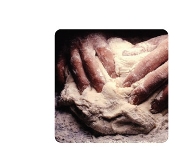[Description]
- Geometric collision (in processing) triggers the DC motor as a haptic feedback.
[Components]
- DC Motor X 1
- Resistor X 2
- Transistor X 1
[Arduino Code]
char val; // Data received from the serial port
int potPin = 0; // select the input pin for the potentiometer
int motorPin = 9; // select the pin for the Motor
void setup() {
pinMode(motorPin, OUTPUT); // Set pin as OUTPUT
Serial.begin(9600);
}
void loop() {
if (Serial.available()) { // If data is available to read,
val = Serial.read(); // read it and store it in val
}
if (val == 'H') { // If H was received
digitalWrite(motorPin, HIGH); // turn the LED on
delay(1000);
} else {
digitalWrite(motorPin, LOW); // Otherwise turn it OFF
}
delay(100); // Wait 100 milliseconds for next reading
}
[Processing Code]
import processing.serial.*;
Serial port; // Create object from Serial class
// Global variables for the ball
float ball_x;
float ball_y;
float ball_dir = 1;
float ball_size = 5; // Radius
float dy = 0; // Direction
// Global variables for the paddle
int paddle_width = 5;
int paddle_height = 20;
int dist_wall = 15;
void setup()
{
size(200, 200);
rectMode(CENTER_RADIUS);
ellipseMode(CENTER_RADIUS);
noStroke();
smooth();
ball_y = height/2;
ball_x = 1;
// Open the port that the board is connected to and use the same speed (9600 bps)
port = new Serial(this, 9600);
}
void draw()
{
background(51);
ball_x += ball_dir * 1.0;
ball_y += dy;
if(ball_x > width+ball_size) {
ball_x = -width/2 - ball_size;
ball_y = random(0, height);
dy = 0;
}
// Constrain paddle to screen
float paddle_y = constrain(mouseY, paddle_height, height-paddle_height);
// Test to see if the ball is touching the paddle
float py = width-dist_wall-paddle_width-ball_size;
if(ball_x == py
&& ball_y > paddle_y - paddle_height - ball_size
&& ball_y < paddle_y + paddle_height + ball_size) {
ball_dir *= -1;
if(mouseY != pmouseY) {
dy = (mouseY-pmouseY)/2.0;
if(dy > 5) { dy = 5; }
if(dy < -5) { dy = -5; }
}
}
// If ball hits paddle or back wall, reverse direction
if(ball_x < ball_size && ball_dir == -1) {
ball_dir *= -1;
port.write('H');
}
// If the ball is touching top or bottom edge, reverse direction
if(ball_y > height-ball_size) {
dy = dy * -1;
}
if(ball_y < ball_size) {
dy = dy * -1;
}
// Draw ball
fill(255);
ellipse(ball_x, ball_y, ball_size, ball_size);
// Draw the paddle
fill(153);
rect(width-dist_wall, paddle_y, paddle_width, paddle_height);
}
[Picture]
- More to come
